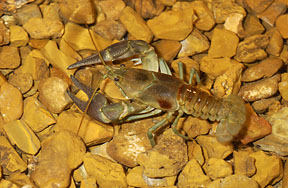State warns about invasive crayfish
Later he received a call from Missouri Department of Conservation officials, who said the creatures were "rusty crayfish," a large-clawed, non-native and invasive species. Named for brown splotches on their sides, rusty crayfish rapidly breed and destroy aquatic habitat.
"I had no clue," Smith recently said. "To me, I always thought a crawdad was a crawdad was a crawdad."
Bait-shop owners are facing an increasing threat from invasive species. Recent studies have shown high numbers of foreign creatures being sold as bait in Missouri, presenting a high potential of getting into waterways.
"I don't want to sound like it's all doom and gloom, but it is this problem that seems to be growing," said Brian Canaday, the conservation agency's former invasive species coordinator. "We are a global community; the world is getting smaller; and we can find things now being distributed intentionally and accidentally" from all over the world.
In June 2006, Canaday said, boaters found zebra mussels underneath a dock at Lake of the Ozarks. The Russian mussel is known to rapidly spread and blanket flat spaces, filtering life-giving plankton from water. Earlier this year, the mussels showed up in Lake Taneycomo near Branson.
Big head and silver carp, introduced from China in the 1970s, have become some of the most plentiful fish in the Mississippi and Missouri rivers.
"The way I explain it to people is basically, invasive species can out-compete native ones," Canaday said. "You may have foreign plants in your front yard, and it might not be a problem. But an invasive plant will take over the entire flower garden and climb up your balcony."
Jim Mertens of Mertens Live Bait and Tackle in Jefferson City has been in business for 20 years. He said he and his wife refuse to deal with dealers who try to sell bait without documentation. "We've been in business too long to take a chance with anything," he said. "If somebody's not a reputable dealer, he's not going to bring anything in these doors."
An influx of rusty crayfish could be particularly ugly, officials said. The three-quarter-pound crayfish is native to the northern United States and Canada but have spread as far south as Maryland, where they're now eating native species and clearing out fish-spawning grounds.
"They're sort of notorious for eliminating aquatic plant beds that serve as spawning grounds and nurseries for fish," said Bob DiStefano, a resource scientist and crayfish specialist with the conservation agency. "We've seen sport fisheries in remote, provincial parks that have been decimated. They can cause a lot of damage."
Smith did not want his bait shop to be part of the problem. He acted fast, driving to shops from Kirksville to south of St. Louis, destroying or freezing the animals while reimbursing merchants. The experience cost him thousands of dollars. He said he now tries to educate bait shops about the dangers of invasive species.
DiStefano and other researchers are about to publish results of a study where they purchased crayfish from every bait shop in Missouri that sells them. The findings show that 16 percent of the crayfish sold here are rusty crayfish, and the bait originated from five outside states.
Few, if any, bait shop owners know what they're selling. Only 13 percent claimed to know the species of crayfish they sell.
Officials said education is the key. In recent years, DiStefano and others have instituted a statewide registry of bait shops, and they've begun to educate shop owners and fishermen with posters and bumper stickers. They've also created a guide to crayfish, so people can easily identify harmful species.
"The odds of an enforcement officer observing someone actually dumping bait
into the water are very minuscule, and once these invasive species are actually
in a body of water, there's very little we can do," DiStefano said. "We're
absolutely convinced that education is our greatest tool."

Photo courtesy of Missouri Department of Conservation
Rusty crayfish are an invasive species state officials seek to eliminate.